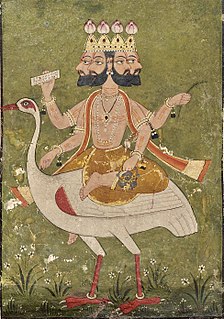The afterlife is an existence some believe that the essential part of an individual's identity or their stream of consciousness continues to have after the death of their physical body. According to various ideas about the afterlife, the essential aspect of the individual that lives on after death may be some partial element, or the entire soul or spirit, of an individual, which carries with it and may confer personal identity or, on the contrary nirvana. Belief in an afterlife is in contrast to the belief in oblivion after death.

The multiverse is a hypothetical group of multiple universes. Together, these universes comprise everything that exists: the entirety of space, time, matter, energy, information, and the physical laws and constants that describe them. The different universes within the multiverse are called "parallel universes", "other universes", "alternate universes", or "many worlds".

The cosmos is the Universe. Using the word cosmos rather than the word universe implies viewing the universe as a complex and orderly system or entity; the opposite of chaos. The cosmos, and our understanding of the reasons for its existence and significance, are studied in cosmology – a very broad discipline covering any scientific, religious, or philosophical contemplation of the cosmos and its nature, or reasons for existing. Religious and philosophical approaches may include in their concepts of the cosmos various spiritual entities or other matters deemed to exist outside our physical universe.

This timeline of cosmological theories and discoveries is a chronological record of the development of humanity's understanding of the cosmos over the last two-plus millennia. Modern cosmological ideas follow the development of the scientific discipline of physical cosmology.

Fakhr al-Dīn al-Rāzī or Fakhruddin Razi often known by the sobriquet Sultan of the theologians, was a Persian polymath, Islamic scholar and a pioneer of inductive logic who made various works in the fields of medicine, chemistry, physics, astronomy, cosmology, literature, theology, ontology, philosophy, history and jurisprudence. He was one of the earliest proponents and skeptics that came up with the concept of Multiverse, and compared it with the astronomical teachings of Quran. A rejector of the geocentric model and the Aristotelian notions of a single universe revolving around a single world, Al-Razi argued about the existence of the outer space beyond the known world.

The celestial spheres, or celestial orbs, were the fundamental entities of the cosmological models developed by Plato, Eudoxus, Aristotle, Ptolemy, Copernicus, and others. In these celestial models, the apparent motions of the fixed stars and planets are accounted for by treating them as embedded in rotating spheres made of an aetherial, transparent fifth element (quintessence), like jewels set in orbs. Since it was believed that the fixed stars did not change their positions relative to one another, it was argued that they must be on the surface of a single starry sphere.

Western esotericism, also known as esotericism, esoterism, and sometimes the Western mystery tradition, is a term under which scholars have categorised a wide range of loosely related ideas and movements which have developed within Western society. These ideas and currents are united by the fact that they are largely distinct both from orthodox Judeo-Christian religion and from Enlightenment rationalism. Esotericism has pervaded various forms of Western philosophy, religion, pseudoscience, art, literature, and music, continuing to affect intellectual ideas and popular culture.
Religious cosmology is an explanation of the origin, evolution, and eventual fate of the universe, from a religious perspective. This may include beliefs on origin in the form of a creation myth, subsequent evolution, current organizational form and nature, and eventual fate or destiny. There are various traditions in religion or religious mythology asserting how and why everything is the way it is and the significance of it all. Religious cosmologies describe the spatial lay-out of the universe in terms of the world in which people typically dwell as well as other dimensions, such as the seven dimensions of religion; these are ritual, experience and emotional, narrative and mythical, doctrinal, ethical, social, and material. Religious mythologies may include descriptions of an act or process of creation by a creator deity or a larger pantheon of deities, explanations of the transformation of chaos into order, or the assertion that existence is a matter of endless cyclical transformations. Religious cosmology differs from a strictly scientific cosmology informed by the results of the study of astronomy and similar fields, and may differ in conceptualizations of the world's physical structure and place in the universe, its creation, and forecasts or predictions on its future. The scope of religious cosmology is more inclusive than a strictly scientific cosmology in that religious cosmology is not limited to experiential observation, testing of hypotheses, and proposals of theories; for example, religious cosmology may explain why everything is the way it is or seems to be the way it is and prescribing what humans should do in context. Variations in religious cosmology include those of Indian origin, such as Buddhism, Hindu, and Jain; the religious beliefs of China; and, the beliefs of the Abrahamic faiths, such as Judaism, Christianity, and Islam. Religious cosmologies have often developed into the formal logics of metaphysical systems, such as Platonism, Neoplatonism, Gnosticism, Daoism, Kabbalah, or the great chain of being.
In esoteric cosmology, a plane is conceived as a subtle state, level, or region of reality, each plane corresponding to some type, kind, or category of being.

Bhagavata Purana also known as Śrīmad Bhāgavata Mahā Purāṇa, Śrīmad Bhāgavatam or Bhāgavata, is one of Hinduism's eighteen great Puranas. Composed in Sanskrit and available in almost all Indian languages, it promotes bhakti (devotion) to Krishna integrating themes from the Advaita (monism) philosophy of Adi Shankara, Vishishtadvaita of Ramanujacharya and Dvaita (dualism) of Madhvacharya.Bhagavatam Purana is not the same as Bhagavad Gita.
Bhagavān or Bhagwan is an epithet for a deity, particularly for the deities of Krishna, Rama and other avatars of Lord Vishnu in Vaishnavism and for Lord Shiva in the Shaivism tradition of Hinduism. The term is used by Jains to refer to the Tirthankaras, particularly Mahavira, and by Buddhists to refer to Lord Buddha in India. In many parts of India and South Asia, Bhagavān represents the abstract concept of a universal God to Hindus who are spiritual and religious but do not worship a specific deity. Bhagavān itself is an acronym of the combination of the 5 elements of nature. Bha means Bhoomi (Earth), Ga means gaggan (Space/Sky), Va means Vayu (Air), A means Agni (Fire) and finally, N means Neer (Water)

Ex nihilo is Latin for "out of nothing": when phrased as ex nihilo nihil fit, "nothing comes from nothing", it means that the universe was formed from eternal matter; as creatio ex nihilo, "creation out of nothing", it means that matter is not eternal but had to be created by some eternal uncaused cause, frequently defined as God.

Cosmic pluralism, the plurality of worlds, or simply pluralism, describes the philosophical belief in numerous "worlds" in addition to Earth, which may harbour extraterrestrial life.
Hindu cosmology is the description of the universe and its states of matter, cycles within time, physical structure, and effects on living entities according to Hindu texts. Time is infinite with a cyclic universe, where the current universe was preceded and will be followed by an infinite number of universes.
In religious or mythological cosmology, the seven heavens refer to seven levels or divisions of the Heavens (Heaven). The concept, also found in the ancient Mesopotamian religions, can be found in Judaism and Islam; a similar concept is also found in some Indian religions such as Hinduism. Some of these traditions, including Jainism, also have a concept of seven earths or seven underworlds both with the metaphysical realms of deities and with observed celestial bodies such as the classical planets and fixed stars. The seven heavens corresponds to the seven luminaires/classical planets known to antiquity. Ancient observers noticed that these heavenly objects moved at different paces in the sky both from each other and from the fixed stars beyond them. Unlike comets, which appeared in the sky with no warning, they did move in regular patterns that could be predicted. They also observed that objects in the sky influenced objects on earth - As Above, So Below - as when movements of the sun affect the behavior of plants or movements of the moon affect ocean tides. Others believe the seven heavens are related to the seven stars of Orion, the Big Dipper, Little Dipper and the Pleaides/Seven Sisters according to ancient western astrology.
Islamic cosmology is the cosmology of Islamic societies. It is mainly derived from the Qur'an, Hadith, Sunnah, and current Islamic as well as other pre-Islamic sources. The Qur'an itself mentions seven heavens.

Since the emergence of the Big Bang theory as the dominant physical cosmological paradigm, there have been a variety of reactions by religious groups regarding its implications for religious cosmologies. Some accept the scientific evidence at face value, some seek to harmonize the Big Bang with their religious tenets, and some reject or ignore the evidence for the Big Bang theory.

The Devi Bhagavata Purana, also known as the Shrimad Bhāgavatam and the Devi Bhāgavatam, is a Sanskrit text that belongs to the Purana-genre of Hindu literature. The text is considered a Mahapurana of India.

Vishnu is one of the principal deities of Hinduism. The "preserver" in the Hindu triad (Trimurti), Vishnu is revered as the supreme being in Vaishnavism as identical to the metaphysical concept of Brahman, and is notable for adopting various incarnations to preserve and protect dharmic principles whenever the world is threatened with evil, chaos, and destructive forces. In the Smarta Tradition of Hinduism, Vishnu is also one of the five equivalent deities worshipped in Panchayatana puja.

Brahma is the creator god in Hinduism. He is also known as Svayambhu (self-born), Vāgīśa, and the creator of the four Vedas, one from each of his mouths. Brahma is consort of Saraswati and he is the father of Four Kumaras, Narada, Daksha, Marichi and many more. Brahma is synonymous with the Vedic god Prajapati, he is also known as Vedanatha, Gyaneshwara, ChaturmukhaSvayambhu, etc, as well as linked to Kama and Hiranyagarbha. He is more prominently mentioned in the post-Vedic Hindu epics and the mythologies in the Puranas. In the epics, he is conflated with Purusha. Although Brahma is part of the Brahma-Vishnu-Shiva Trimurti, ancient Hindu scriptures mention multiple other trinities of gods or goddesses which do not include Brahma.












